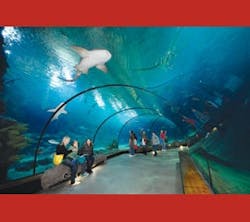Rotterdam Zoo’s Oceanium, which opened in 2001, is one of the most popular tourist attractions in the Netherlands, with 1.4 million visitors in 2012. It recently installed an ozone system to treat 8,113 cu meters of water, allowing for the reuse of treated water while reducing both cost and environmental impact.
The system installation resulted from a challenge the zoo faced when its ozone generators failed, endangering the sea life inside and detracting from visitors’ viewing experience. Ozone is responsible for maintaining water quality for healthy fish communities as well as for improving clarity of water for the viewing public.
“The Oceanium is a sealife habitat that is extremely sensitive to changes in water quality,” said Mirsada Mutapcic, chemical analyst and water quality supervisor at the Oceanium facility. “Rotterdam Zoo places a great deal of importance on the quality of water and has installed high-quality purification systems to keep the water in the best possible condition. If one of the systems or ozone generators fails, action must be taken immediately, because the increased concentration of nitrogen, particularly ammonia, can be life threatening for the animals. Ozone plays a key role in the removal of these substances.”
Two of Xylem’s Wedeco GSO50 systems were supplied to rid the water of organic and inorganic particles and dissolved substances; ensure micro-flocculation of organic substances; and destabilize gelatinous substances.
The special advantage of ozone is the environmentally sustainable way in which it works. Harmful substances, colors, odors and microorganisms are destroyed directly by oxidation, without the formation of chlorinated byproducts.
Ozone is a natural, gaseous molecule and frequently is found in nature. In the ozone layer, it protects our planet against ultraviolet solar radiation; ozone can even be formed in low concentrations by lightning bolts or on hot summer days. Applied correctly, it is ideally used as an effective and sustainable alternative to oxidation with chlorine, adsorption (e.g., activated carbon) or separation (e.g., reverse osmosis).
The Oxidative Effect of Ozone
Ozone consists of three oxygen atoms. Under normal, near-earth conditions, the gas is unstable and thus reactive. The ozone molecule reacts quickly with a number of organic and inorganic compounds, either directly, by acting on the ozone molecule, or indirectly, through hydroxyl radicals that are created. Ozone usually is used up completely by this oxidation process and breaks back down into oxygen. Any remaining ozone in the off-gas is converted back to oxygen by a residual ozone destructor.
Upon failure of the original ozone generators, Rotterdam Zoo contacted Xylem to seek replacement treatment systems. As a short-term measure, a temporary disinfection unit was installed immediately while the replacement ozone treatment system was being built. Xylem worked with a local service partner and the zoo’s design and construction team on the development of the new customized oxidation water treatment unit. By providing a temporary system immediately (using a soil decontamination and purification technique for water treatment purposes) and subsequently a long term water treatment solution, water quality at the Oceanium was maintained.
The new system has resulted in increased reliability, with uptime improved by 100%. In addition, the system is operating at only 70% of its capacity, meaning energy costs also have been reduced.
“Ozone is the optimal treatment solution for aquariums and oceanariums,” said Hans Wijers, treatment manager for Xylem in the Netherlands. “As it is chemical free and environmentally friendly, it has no negative impact on sea life.”
Download: Here


